Create Efficient, Ergonomic Workstations with Aluminum Framing
Ergonomics is the science of fitting jobs to workers instead of trying to get the worker to fit the job and focuses on designing workstations, tools and tasks for safety, efficiency and comfort, according to the U.S. Occupational Safety & Health Administration (OSHA). When workstations are not designed ergonomically, it may result in injuries such as musculoskeletal disorders (MSDs) caused by lifting, pushing or pulling, gripping, awkward or prolonged postures, repetitive activities, overhead work and contact stress and vibration.

MSD injuries are not only painful for the worker, but they can be costly for the employer. MSD injuries equate to $20 billion in direct costs to employers, while indirect costs such as lost productivity, increased workers’ compensation insurance costs, wages paid to other, non-injured employees to cover overtime and wages paid to injured workers for absences not covered by workers’ compensation can really add up. As a matter of fact, some experts suggest that these costs can be up to five times the direct cost of the injury itself.
Fortunately, there is a simple safety solution. An OSHA-supplied worksheet on ergonomics, suggests that the number one way to reduce ergonomic risks is by employing engineering improvements that rearrange, modify, redesign or replace tools, equipment and workstations in an effort to reduce or eliminate contributing factors to MSDs. Ergonomic workstations constructed of aluminum t-slot framing offer an affordable and simple safety solution that can help keep employees injury free, while also increasing their efficiency.
Ergonomic Workstations Offer a Safety Solution
OSHA’s information on ergonomics states that when a worker’s body is stressed by awkward postures and repeated movements, it is subjected to MSDs, which are injuries to the soft tissue muscles, tendons, ligaments, nerves, joints and blood vessels caused by wear and tear on the body from repetition, awkward positions, stationary positions and other on-the-job risks.
However, by fitting the workplace to the worker via ergonomic workstations, it can lessen muscle fatigue and reduce the risk of developing work-related MSDs while also increasing physical and job-related efficiency.
Ergonomic workstations offers the following benefits:
- Improved physical health: By adjusting a workstation to fit an employee’s height and posture, it reduces muscle strain, improves circulation and prevents neck strain.
- Better cognitive ability: Poorly designed workstations can cause discomfort, which is counterproductive to concentration. Ergonomic workstations, however, eliminate this issue and allow employees to better perform their tasks.
- Increased productivity: By eliminating discomfort and putting all tools and equipment at the right height and location, properly designed ergonomic workstations not only allow employees to be more physically comfortable and mentally present, but also make the workflow more efficient, leading to increased productivity.
Using Aluminum Framing Systems as a Safety Solution
T-slot aluminum framing and accompanying fasteners, accessories and parts can be used to configure customized ergonomic workstations that fit the worker and the process. Extruded aluminum framing systems are modular so they allow users to create workstations that fit the workforce and the tasks.
Ergonomic workstations created from aluminum framing systems can be designed to accommodate the height of the worker and to conform to the natural movements and reach of the operator, reducing awkward positions and reaches. The ability to pressurize a t-slot aluminum frame allows users to provide a built-in overhead rail for multiple tools, reducing the risk of injury associated with switching and holding heavy equipment for extended periods.
In addition, t-slot aluminum framing features channels that permit users to mount components directly to the workstation, providing infinite positioning and easy accessibility to accessories such as storage and organization bins, safety controls, scanners or computer monitors. This reduces the reaching, lifting and awkward positions that can cause MSDs.
The Benefits of Aluminum Framing System Workstations
Using aluminum framing systems to create ergonomic workstations is simple, thanks to the inherent modularity, but it also has the potential to:
- Reduce workers’ compensation costs by up to 60%
- Decrease maintenance downtime
- Improve productivity by 25% or more
- Decrease employee turnover
- Reduce OSHA fines
Customized workstations from 80/20 Solutions have what it takes to provide ergonomically correct workstations. The aluminum t-slot profiles and accompanying fasteners, accessories and parts allow users to configure durable workstations to fit the employee and the workflow, while containing tools, materials and resources in an organized manner, helping to reduce the risk of developing MSDs. Aluminum framing systems from 80/20 Solutions can be easily and quickly reconfigured as changes are implemented because assembly is straightforward and only requires simple hand tools. The extruded aluminum construction is strong, yet lightweight, and is comparable in strength to steel, making it suitable for light- to heavy-duty applications throughout the facility.
To learn more about designing ergonomic workstations from extruded aluminum framing in an effort to protect employees and reduce injury-related costs, please contact JHFOSTER, a Tavoron company today.